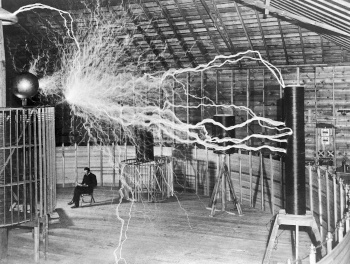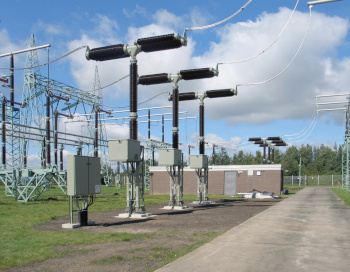Sulfur Hexafluoride
October 16, 2023
My
laboratory was sited in a
research center that was also home to many
high powered lasers.
Q-switching is one technique for producing
megawatt laser
pulses, one consequence of which is the generation of high
electric fields in the
electromagnetic light pulse. The maximum
electric field strength, called the
dielectric strength, is about three
megavolts per
meter in
air. A multi-megawatt laser pulse of a
centimeter diameter will produce electric fields of this strength to
ionize the air and create a
spark. The tick-tick of such sparks would often
reverberate through the research center
hallways.

Nikola Tesla (1856-1943) pictured in December, 1899, in his laboratory in Colorado Springs,Colorado, with his high voltage spark generator. This photograph was a double exposure, and Tesla was not actually in the room.
The photograph without Tesla appears as fig. 8 in the article, "The Problem of Increasing Human Energy," in the June, 1900, issue of The Century Magazine.
(Wikimedia Commons image of an original by Dickenson V. Alley, restored by Lošmi. Click for larger image.)
Electric relays, and their high
current cousins known as
contactors, will also produce a spark when making or breaking a
circuit. Although the voltages involved are less than a million
volts, the spacing between the switched
contacts at make or break is so small that the field strength in volts per meter is very large; so, a spark is produced and the switched contacts are
eroded. This is like the
economic imperative to increase
return on assets (ROA). You can either increase the return, or reduce the assets.
The air spark erosion of switched contacts caused by making or breaking current is typically eliminated by the addition of a
series combination of a
resistor and a small value
capacitor in
parallel with the contacts. The
charging of the capacitor when the contacts open reduces the voltage for the short interval when
arcing happens. The resistor acts as a current limiter when the contacts close, thereby preventing arcing at closure.
While this
palliative works well for current switching in
homes and small
industrial settings, much larger switches are needed for the
high voltage transmission lines that
criss-cross the
countryside to link
generators to users of
electric power. In order to reduce
resistive heating losses, these transmission lines are designed for high voltage that requires less current for the same power. However, the currents are still large enough for arcing to be a problem.
A method for
arc suppression in high voltage
switchgear is placing the contacts in
sulfur hexafluoride (SF6) rather than air. Sulfur hexafluoride has about three times the dielectric strength of air, between 8.5-9.8 MV/m. Sulfur hexafluoride has been used in this application since the
1950s, but it's recently become problematic with our increased sensitivity to
global warming. Sulfur hexafluoride is a potent
greenhouse gas with a global warming potential by
weight that's 23,900 times that of
carbon dioxide CO2 and an estimated atmospheric
residence time of 3,200
years.[1-3]

High voltage (380 kilovolt) switchgear at the Krümmel Nuclear Power Plant. sulfur hexafluoride is contained in the contactor region at the junction of the "T" elements.
The nuclear power plant is of the boiling water reactor type with an output power of about 1,400 megawatts.
(Wikimedia Commons image by Jens Bender. Click for larger image.)
SF
6 is used in many electrical devices, but its use was advantageous in some
consumer products as well. From 1989 and 2006,
Nike's Air shoes used SF
6 because it's
non-reactive and its large molecule has a slow
leak rate.[4] A 1978
patent proposes filling
tennis balls with SF
6, the advantage being that they would remain
pressurized longer than air-filled balls.[5] However, the largest use of SF
6 is for high-voltage
circuit breakers.[3] Older versions of such circuit breakers might contain 2,000
pounds of SF
6, but modern breakers will typically employ less than a hundred pounds (45,359 grams). Since the
density of SF
6 is 6.17
grams/
liter, a hundred pounds is a substantial 7,350 liters.

The ubiquitous tennis ball. Older balls are useful in applications other than tennis.
As stated in the abstract of the 1978 patent, "...the inflation gas includes predetermined mixed amounts of air and sulfur hexafluoride (SF6) gas which effectively enables the ball to retain its pressurized state within a desired range of pressures for a period of time significantly longer than the ball would remain pressurized if the inflation gas were air alone."[5]
Not surprisingly, there are strict standards for the mechanical properties of balls used in professional sports. The International Tennis Federation's specification for a tennis ball requires a mass between 56.0 and 59.4 grams, a diameter between 6.541 and 6.858 cm, and a bounce, onto a concrete surface from a height of 254 cm, between 135 and 147 cm.[6]
Wikimedia Commons image (modified) by Noah Wulf.
According to the 2021
Inventory of U.S. Greenhouse Gas Emissions and Sinks,
electrical transmission and
distribution is responsible for about 75% of all SF
6 emissions in the
United States.[3] Gas
leaks can occur from aging equipment, during
maintenance, removal from service, and during equipment
manufacturing and
installation.[3] In 1999, the
United States Environmental Protection Agency started a
voluntary tracking and reduction effort for SF
6, inviting
companies to share
data on finding and fixing leaks, gas
recycling, and the reduction in the amount of gas used.[2]
California and
Massachusetts have mandated the reduction of SF
6 in electrical equipment.[2] One of the largest
electric utilities in the country,
Pacific Gas and Electric (PG&E), discovered in 1999 that it was losing between 20,000 and 30,000 pounds of SF
6 per year, which is the equivalent global warming effect of about 57,000
automobiles.[2] By 2004, PG&E had reduced this annual loss rate to 11,000 pounds.[2] According to the EPA, SF
6 emissions decreased from 4.3 million
metric tons of CO
2 equivalent to 2.4 million metric tons between 2011 and 2021.[2]
Of course, the best solution to the SF
6 global warming problem is its elimination from such electrical equipment. However, when things are working well, there is resistance to such change. It's estimated that SF
6-free circuit breakers will not be widely available for at least a
decade; and, in that decade, there will be increased need for such devices in the shift to
renewable energy sources.[2] When SF
6 equipment is finally removed from electrical systems, millions of pounds of SF
6 in existing equipment will need to be removed.[2] Hitachi and Mitsubishi presently offer decommissioning services with SF
6 removal.[2]
Hitachi and
Mitsubishi are presently manufacturing alternative equipment that's free of SF
6.[2] One alternative is the use of
hermetically sealed dry air, a technology now used in lower voltage equipment.[2] Another alternative is replacing SF
6 with a mixture of carbon dioxide,
oxygen, and
C4-fluoronitrile.[2] While C4-fluoronitrile is itself a greenhouse gas, it is far less harmful than SF
6, and it has about twice the dielectric strength of SF
6.
References:
- A. R. Ravishankara, S. Solomon, A. A. Turnipseed, and R. F. Warren, "Atmospheric Lifetimes of Long-Lived Halogenated Species," Science, vol. 259, no. 5092 (January 8, 1993), pp. 194-199, DOI: 10.1126/science.259.5092.194
- Anya Litvak, "A greener way to stop the current: Phasing out a climate super-menace in the grid," Pittsburgh Post-Gazette, June 20, 2023.
- Electric Power Systems Partnership, Sulfur Hexafluoride (SF6) Basics, United States Environmental Protection Agency, April 14, 2023.
- Hayley Bennett, "Magnificent molecules - Sulfur hexafluoride," Royal Society of Chemistry.
- Dale Lee Koziol and Thomas Freeman Reed, "Tennis Ball," US Patent no. 4,098,504, July 4, 1978.
- Howard Brody, "The tennis‐ball bounce test," Phys. Teach., vol. 28, no. 6 (September, 1990) pp. 407ff., http://dx.doi.org/10.1119/1.2343088.
Linked Keywords: Laboratory; research institute; research center; power (physics); high power; laser; Q-switching; megawatt; pulse (physics); electric field; electromagnetic field; light; intensity (physics); strength; dielectric strength; volt; megavolt; meter; atmosphere of Earth; air; centimeter; diameter; ionization; ionize; electric spark; reverberation; reverberate; hallway; Nikola Tesla pictured with his high voltage spark generator; Nikola Tesla (1856-1943); Colorado Springs,Colorado; high voltage; photograph; multiple exposure; double exposure; The Century Magazine; image restoration; restored; Lošmi; electric relay; current; cousin; contactor; electrical network; circuit; electrical contact; erosion; eroded; economics; economic; imperative; return on assets (ROA); series and parallel circuits; series; resistor; capacitor; parallel; electric charge; charging; arcing; palliative; home; industry; industrial; overhead power line; high voltage transmission line; criss-cross; rural area; countryside; electric generator; electric power; Joule heating; resistive heating; arc suppression; switchgear; sulfur hexafluoride (SF6); 1950s; global warming; greenhouse gas; weight; carbon dioxide CO2; residence time; year; High voltage load switches at the Krümmel Nuclear Power Plant; kilovolt; Krümmel Nuclear Power Plant; boiling water reactor; electric power; megawatt; Wikimedia Commons; final good; consumer product; Nike, Inc.; Nike Air Max; chemical reaction; non-reactive; leak; rate (mathematics); patent; tennis ball; pressure; pressurized; circuit breaker; pound (mass); density; gram; liter; ubiquitous; tennis; abstract (summary); patent; inflatable; inflation; gas; mixture; mixed amounts; pressure; pressurized; technical standard; mechanical properties; professional sports; International Tennis Federation; specification; mass; gram; diameter; centimeter; cm; deflection; bounce; concrete; surface; altitude; height; Noah Wulf; Inventory of U.S. Greenhouse Gas Emissions and Sinks; electric power transmission">electrical transmission; electric power distribution; United States; leak; maintenance, repair and operations; manufacturing; installation; United States Environmental Protection Agency; volunteering; voluntary; company; companies; data; recycling; California; Massachusetts; electric utility; Pacific Gas and Electric (PG&E); automobile; metric ton; decade; renewable energy source; Hitachi; Mitsubishi; hermetic seal; hermetically sealed; oxygen; C4-fluoronitrile.